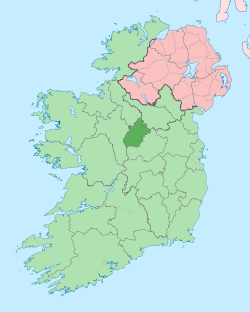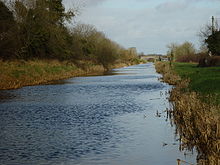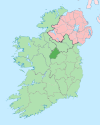- County Longford
-
County Longford
Contae an Longfoirt
Coat of armsMotto: Daingean agus Dílis (Irish)
"Strong and Loyal"Country Ireland Province Leinster Dáil Éireann Longford-Westmeath EU Parliament East County seat Longford Government – Type County Council Area – Total 1,091 km2 (421.2 sq mi) Area rank 29th Population (2011) 38,970 – Rank 31st Car plates LD Website longford.ie County Longford (Irish: Contae an Longfoirt) is a county in Ireland. It is part of the Midlands Region and is also located in the province of Leinster. It is named after the town of Longford.Longford County Council is the local authority for the county. The population of the county is 38970 according to the 2011 census.
Contents
Geography and political subdivisions
With an area of 1,091 km2 (421 sq mi) and a population of 38,970, Longford is the fourth smallest of the 32 counties in area and second smallest in terms of population.[1] It is also the fourth smallest of Leinster’s 12 counties by size and smallest by population.
Towns and villages
Historical populations Year Pop. ±% 1653 5,150 — 1659 5,392 +4.7% 1821 107,570 +1895.0% 1831 112,558 +4.6% 1841 115,491 +2.6% 1851 82,348 −28.7% 1861 71,694 −12.9% 1871 64,501 −10.0% 1881 61,009 −5.4% 1891 52,647 −13.7% 1901 46,672 −11.3% 1911 43,820 −6.1% 1926 39,847 −9.1% 1936 37,847 −5.0% 1946 36,218 −4.3% 1951 34,553 −4.6% 1956 32,969 −4.6% 1961 30,643 −7.1% 1966 28,989 −5.4% 1971 28,250 −2.5% 1979 30,785 +9.0% 1981 31,140 +1.2% 1986 31,496 +1.1% 1991 30,296 −3.8% 1996 30,166 −0.4% 2002 31,068 +3.0% 2006 34,391 +10.7% 2011 38,970 +13.3% [2][3][4][5][6][7] - Abbeylara
- Abbeyshrule
- Ardagh
- Aughnacliffe
- Ballinamuck
- Ballymahon
- Ballinalee
- Brickeens
- Cloondara
- Colehill
- Drumlish
- Edgeworthstown
- Ennybegs
- Granard
- Keenagh
- Killashee
- Killoe
- Lanesborough
- Lisryan
- Longford
- Moydow
- Mullinalaghta
- Newtowncashel
- Newtownforbes
- Taghshinny
Physical geography
Most of Longford lies in the basin of the River Shannon with Lough Ree forming much of the county's western boundary. The north-eastern part of the county, however, drains towards the River Erne and Lough Gowna. Lakeland, bogland, pastureland, and wetland typify Longford's generally low-lying landscapes: the highest point of the county is in the north-west - Carn Clonhugh (also known as Cairn Hill) at 279 m (916 feet). Cairn Hill is the site of a television transmitter broadcasting to much of the Irish midlands. Longford has the 30th highest county peak ahead of Meath and Westmeath. In general, the northern third of the county is hilly, forming part of the drumlin belt stretching across the northern midlands of Ireland. The southern parts of the county are low-lying, with extensive areas of raised bogland and the land being of better quality for grazing and tillage.
History
The territory now comprising County Longford was traditionally known as Annaly (Anghaile in Irish), Tethbae or Teffia (Teabhtha in Irish) and formed the territory of the Farrell clan. After the Norman invasion of the 12th century, Annaly was granted to Hugh de Lacy as part of the Liberty of Meath. An English settlement was established at Granard, with Norman Cistercian monasteries being established at Abbeylara and Abbeyshrule, and Augustinian monasteries being established at Abbeyderg and at Saints' Island on the shore of Lough Ree. Monastic remains at Ardagh, Abbeylara, Abbeyderg, Abbeyshrule, Inchcleraun Island in Lough Ree, and Inchmore Island in Lough Gowna are reminders of the county's long Christian history.
However, by the 14th century, English influence in Ireland was on the wane. The town of Granard was sacked by Edward Bruce's army in 1315, and the O'Farrells soon recovered complete control over their former territory.
The county was officially shired in 1586 in the reign of Elizabeth I, but English control was not fully established until the aftermath of the Nine Years War. County Longford was added to Leinster by James I in 1608 (it had previously been considered part of Connacht), with the county being divided into six baronies and its boundaries being officially defined. The county was planted by English and Scottish landowners in 1620, with much of the O'Farrell lands being confiscated and granted to new owners. The change in control was completed during the Cromwellian plantations of the 1650s.
The county was a centre of the 1798 rebellion, when the French expeditionary force led by Humbert which had landed at Killala were defeated outside the village of Ballinamuck on 8 September by a British army led by Cornwallis. Considerable reprisals were inflicted by the British on the civilian inhabitants of the county in the aftermath of the battle.
A revolutionary spirit was again woken in the county during the Irish War of Independence when the North Longford flying column, led by Seán Mac Eoin, became one of the most active units on the Irish side during that war.
Education
There are many national and secondary schools located in the county such as Moyne Community School, St. Mels and the Convent (Longford, Granard, Ballymahon, Lanesborough).
Demographics
Longford’s population growth during the period 2002-2006 (10.6%) has been stronger than the National average (8.2%).[8]
Agriculture is an important facet in the way of life and for the economy in County Longford. There are 73,764 hectares of area farmed in the county. There are approximately 126,904 cattle in the county too.[9]
See also
- List of abbeys and priories in the Republic of Ireland (County Longford)
- Lord Lieutenant of Longford
- High Sheriff of Longford
- Category: People from County Longford
References
- ^ Corry, Eoghan (2005). The GAA Book of Lists. Hodder Headline Ireland. pp. 186–191.
- ^ For 1653 and 1659 figures from Civil Survey Census of those years, Paper of Mr Hardinge to Royal Irish Academy March 14, 1865.
- ^ Census for post 1821 figures.
- ^ http://www.histpop.org
- ^ http://www.nisranew.nisra.gov.uk/census
- ^ Lee, JJ (1981). "On the accuracy of the Pre-famine Irish censuses". In Goldstrom, J. M.; Clarkson, L. A.. Irish Population, Economy, and Society: Essays in Honour of the Late K. H. Connell. Oxford, England: Clarendon Press.
- ^ Mokyr, Joel; O Grada, Cormac (November). "New Developments in Irish Population History, 1700-1850". the Economic History Review 37 (4): 473–488. doi:10.1111/j.1468-0289.1984.tb00344.x. http://www3.interscience.wiley.com/journal/120035880/abstract.
- ^ "Demographic context" (PDF). Offaly County Council Development Plan 2009 - 2015. http://www.offaly.ie/NR/rdonlyres/A4AD027E-87E4-4353-917B-47C75D92768F/1095/Chapter2ContextandChallenges_FEB08.pdf. Retrieved 2008-06-28.
- ^ http://www.cso.ie/studentscorner/statsfactslongford.htm
External links
- County Longford Official Website
- Longford County Council
- Longford Ancestry
- Farrells of Longford
- Corboy Presbyterian: County Longford's only Presbyterian Church
Places in County Longford Towns Villages and
Townlands- List of townlands in County Longford
- Category:Mountains and hills of County Longford
- Category:Rivers of County Longford
- Category:Geography of County Longford
Counties of Ireland The counties are listed per provinceConnacht Munster Leinster Ulster Italics denote non-administrative counties. Brackets denote eponymous cities or non-traditional counties. † denotes counties of Northern IrelandCategories:- County Longford
- Leinster
- Counties of the Republic of Ireland
- Local administrative units of the Republic of Ireland
Wikimedia Foundation. 2010.




